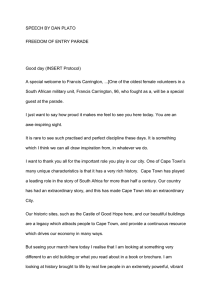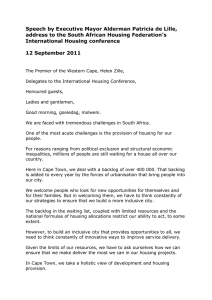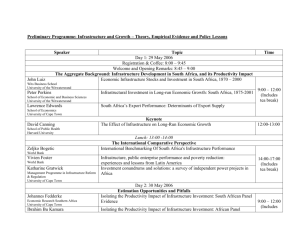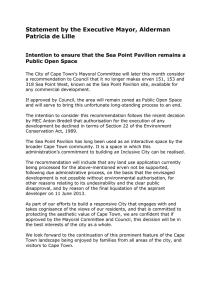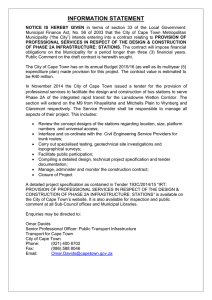Q&A - World Design Capital Cape Town 2014
advertisement
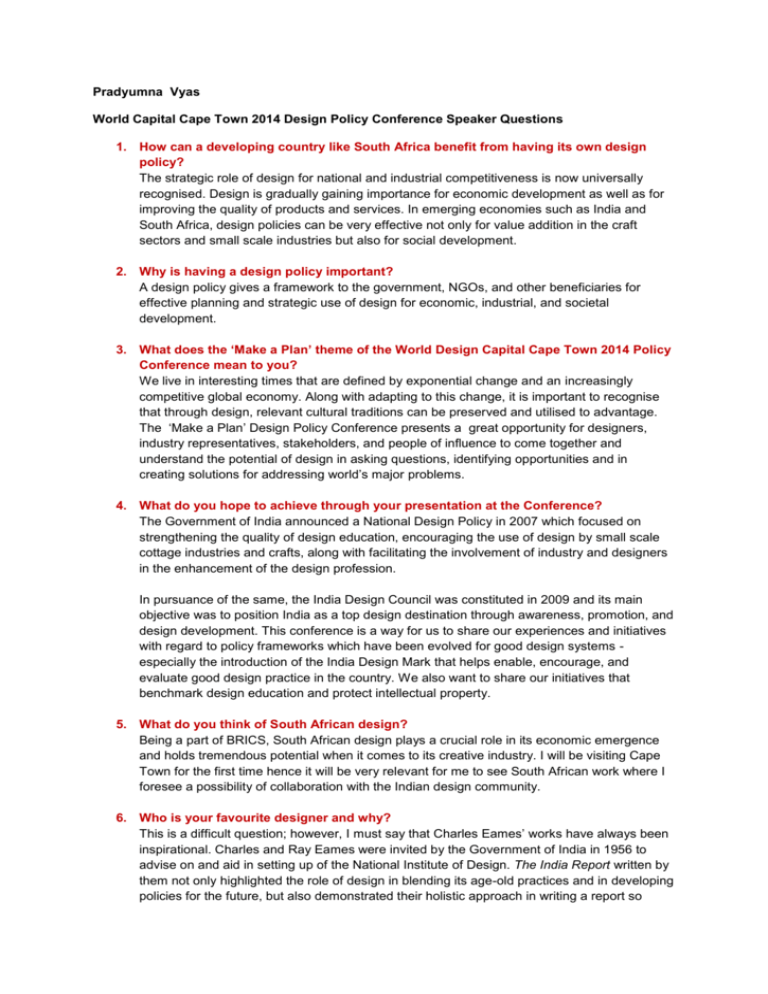
Pradyumna Vyas World Capital Cape Town 2014 Design Policy Conference Speaker Questions 1. How can a developing country like South Africa benefit from having its own design policy? The strategic role of design for national and industrial competitiveness is now universally recognised. Design is gradually gaining importance for economic development as well as for improving the quality of products and services. In emerging economies such as India and South Africa, design policies can be very effective not only for value addition in the craft sectors and small scale industries but also for social development. 2. Why is having a design policy important? A design policy gives a framework to the government, NGOs, and other beneficiaries for effective planning and strategic use of design for economic, industrial, and societal development. 3. What does the ‘Make a Plan’ theme of the World Design Capital Cape Town 2014 Policy Conference mean to you? We live in interesting times that are defined by exponential change and an increasingly competitive global economy. Along with adapting to this change, it is important to recognise that through design, relevant cultural traditions can be preserved and utilised to advantage. The ‘Make a Plan’ Design Policy Conference presents a great opportunity for designers, industry representatives, stakeholders, and people of influence to come together and understand the potential of design in asking questions, identifying opportunities and in creating solutions for addressing world’s major problems. 4. What do you hope to achieve through your presentation at the Conference? The Government of India announced a National Design Policy in 2007 which focused on strengthening the quality of design education, encouraging the use of design by small scale cottage industries and crafts, along with facilitating the involvement of industry and designers in the enhancement of the design profession. In pursuance of the same, the India Design Council was constituted in 2009 and its main objective was to position India as a top design destination through awareness, promotion, and design development. This conference is a way for us to share our experiences and initiatives with regard to policy frameworks which have been evolved for good design systems especially the introduction of the India Design Mark that helps enable, encourage, and evaluate good design practice in the country. We also want to share our initiatives that benchmark design education and protect intellectual property. 5. What do you think of South African design? Being a part of BRICS, South African design plays a crucial role in its economic emergence and holds tremendous potential when it comes to its creative industry. I will be visiting Cape Town for the first time hence it will be very relevant for me to see South African work where I foresee a possibility of collaboration with the Indian design community. 6. Who is your favourite designer and why? This is a difficult question; however, I must say that Charles Eames’ works have always been inspirational. Charles and Ray Eames were invited by the Government of India in 1956 to advise on and aid in setting up of the National Institute of Design. The India Report written by them not only highlighted the role of design in blending its age-old practices and in developing policies for the future, but also demonstrated their holistic approach in writing a report so rooted in culture and social development that it undoubtedly places them among the famous design thinkers of the world. 7. Which element of design interests you most? Today, design has evolved from merely being a vocation dealing with form and function to a new approach of developing business models. The social impact constituted by inclusivity, dignity, empowering people who are not so privileged and developing designs which are ecofriendly happen to be the biggest strengths of design according to me. Design holds in its grasp the power to bring harmony in the society. 8. How did you get interested in design? When you have a creative and analytical bent of mind, one manages to unearth a range of possibilities while pursuing their interests. In the course of my multidisciplinary and multidimensional education, looking at opportunities in the rich cultural backdrop that is India enhanced my empathy for the society and our environment. I firmly believe that design has always been an integral part of our ethos and it is design that will be the solution to many of the problems faced by the world today. 9. Anything else you’d like to add? Design plays an elementary role when it comes to offering better choices to people. Many a time, it is misused when it is addressing the needs of greed with apathy for environment and the people around it. No society can grow if we do not think of inclusive development. Hence in the policy framework, it is very important that creative industries address the holistic approach that calls for a sustainable environment and human development to go hand in hand.


